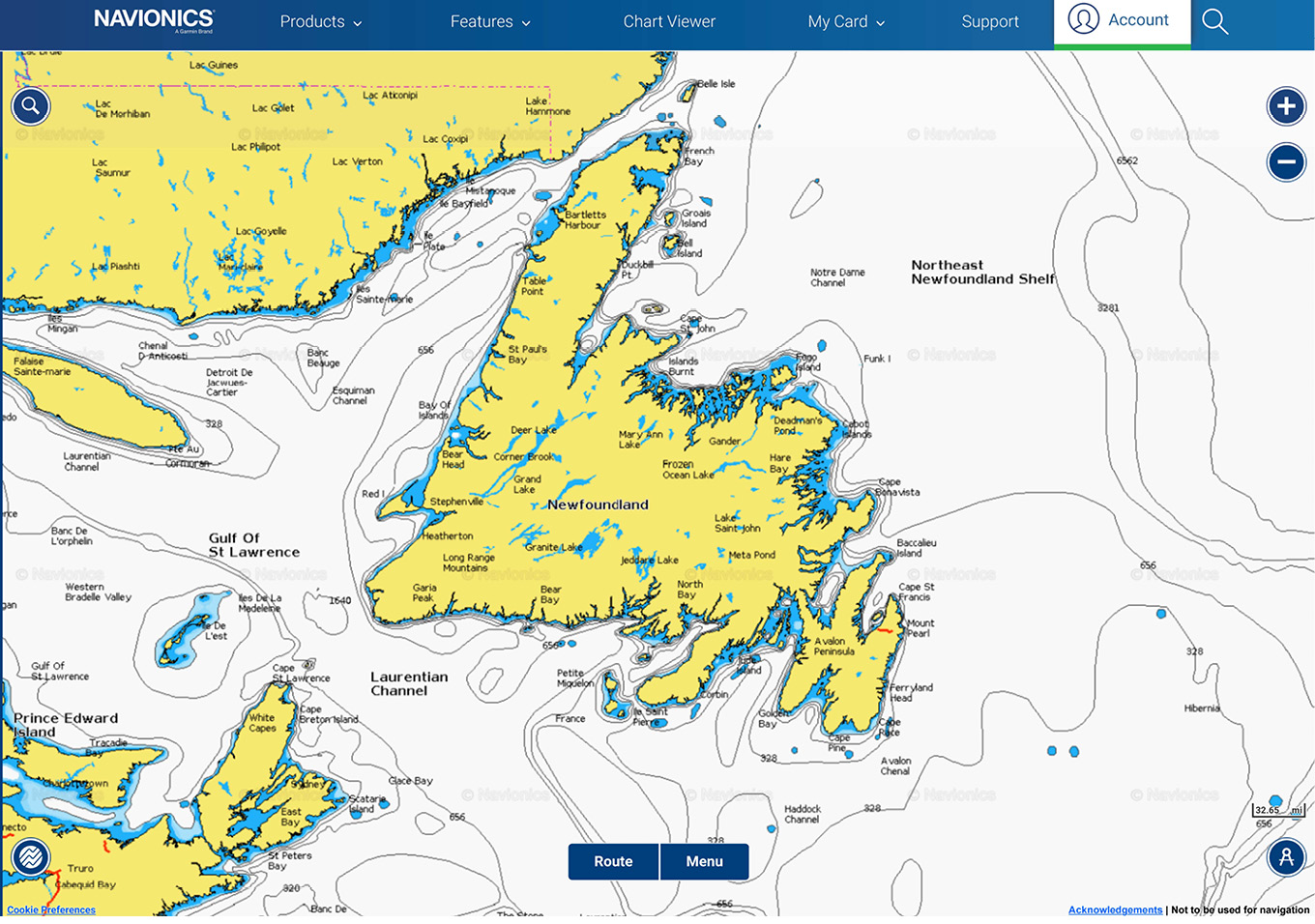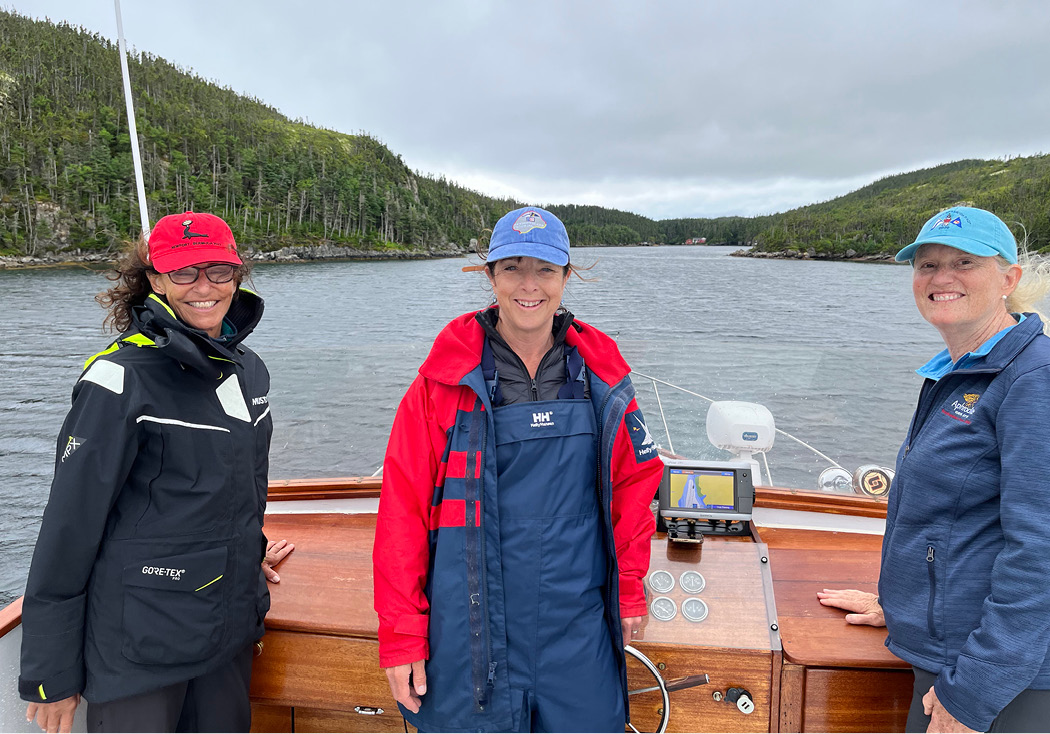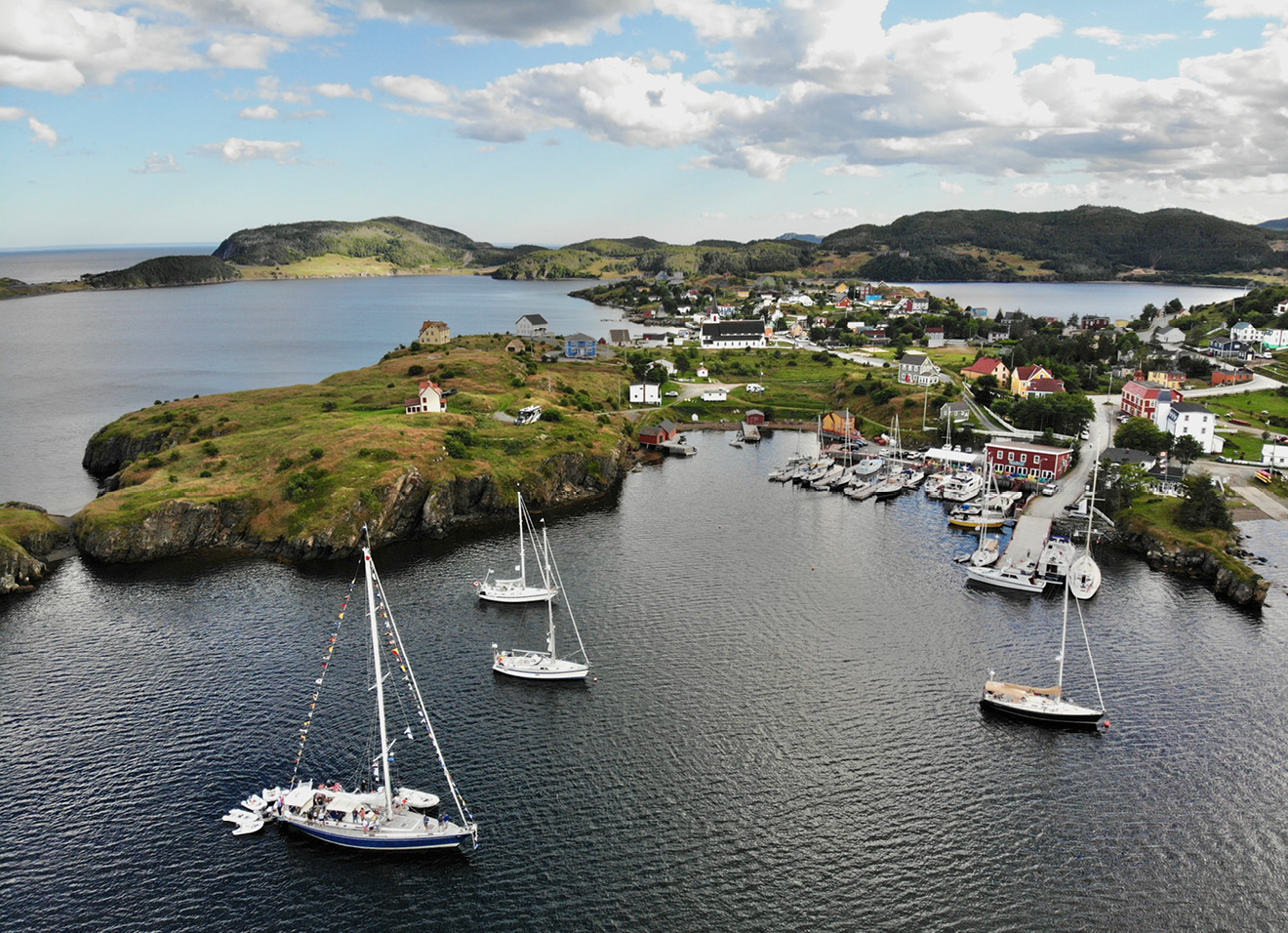By Chris Otorowski, Cruising Club of America Pacific Northwest Station and Narragansett Bay Post
The long-anticipated Newfoundland Cruise finally happened in July 2022. This was the first CCA cruise to Newfoundland in about 30 years, and Bill Bowers and the Royal Newfoundland Yacht Club did a beautiful job organizing it. The run-up involved numerous Zoom meetings with members of the RNYC and multiple year-long delays due to COVID exigencies.

Chace Anderson’s Bonnie Rye in Pope’s Harbour
We had the newly published CCA Cruising Guide for Newfoundland to educate us and keep us off the many underwater granite boulders. The recommended gear list included long underwear, gloves, lots of fleece, bug repellant, and foulies. What our inveterate organizers did not know was that we were destined to experience perhaps one of Newfoundland’s finest two-week stretches of weather ever. Sunshine greeted us most days, and the temperature was often in the 80s. We did have a bit of rain, including a short drenching downpour, at Bonavista, and again at Barrows Harbour. Because the weather was so spectacular, the winds were not, which led to a great deal of motor-sailing.
Newfoundland has a population of roughly 520,000 hardy souls, half of whom are in St. John’s and environs. It is often described as the “most Irish place outside of Ireland” and used to be known as the Dominion of Newfoundland before surrendering its sovereignty to the British Commonwealth in 1933. In 1949 it joined the Canadian Confederation and later was joined with Labrador to form a province.
The geography is harsh but inviting, the result of tectonic plates shifting over millennia to produce dramatic rock formations, like the headland on which the Cape Bonavista Lighthouse sits and the Long Range Mountains, which have been determined to be the northernmost section of the Appalachian Mountain chain — another common bond we have with Canada!

Newfoundland is often described as the “most Irish place outside of Ireland.”
Newfoundland has a history of human habitation going back 9,000 years. Leif Ericson arrived in Newfoundland in approximately 1001 AD. Nearly 500 years later, John Cabot, with King Henry VII’s charter in hand, landed on the Bonavista Peninsula on June 24, 1497 (the precise date is in question) and then again in 1499 and 1500. Later, the Portuguese Crown claimed Newfoundland as its own and began taxing the cod- fishing trade. In 1583 the island came under the rule of Queen Elizabeth I. Newfoundland was valued for its proximity to the Grand Banks, one of the world’s richest fishing grounds. Cod fishing ruled. Over the next 100-plus years, Spain, England, and France fought for control of Newfoundland. In 1825 Newfoundland achieved official colonial status in the British Empire, and in 1907 it acquired dominion status, which meant self-government.
During World War II, when German submarines were attacking merchant ships in the North Atlantic, the United States built air, army, and naval bases on Newfoundland, which brightened the economic picture for Newfoundlanders who had been hit hard by the Great Depression. After the war, a population-transfer policy led to 30,000 Newfoundlanders being relocated to “growth centers” with better infrastructure within the province. Three hundred communities were abandoned under that policy.
In 1992, a moratorium was placed on cod fishing because the cod population had been depleted by the overfishing brought on by advanced trawler technology. The moratorium put thousands of Newfoundlanders out of work, forcing them to look to other occupations to sustain themselves. Today, a very small quota allows for some commercial cod fishing, and individual anglers have a reasonable daily limit.

On the flybridge of the Moya C are (l- r) Anne Kolker, RNYC Commodore Moya Cahill, and Elizabeth Gowell
During the cruise, Shawn and I were joined on Aphrodite, our Swan 68, by CCA members Jay and Elizabeth Gowell and Andrew and Julie Kallfelz, as well as Captain Murray Jacob and first mate Alex Charney. Still being a working stiff, I was unable to take the time to sail to Newfoundland, so Murray, a crusty but lovable Aussie, brought Aphrodite from Newport to St. John’s. We flew in on a very long red-eye flight from Los Angeles by way of Toronto. Aphrodite was at the dock in St. John’s along with heavy-duty commercial vessels. We spent the next day provisioning for the two-week trip.
Many of the twelve other participating vessels had the good fortune to sail to St. John’s from Maine and other points, including stopping in the French territory of St. Pierre and Miquelon on the southwest tip of Newfoundland. They had some challenging winds and seas both coming and going.
On Saturday, July 24, we departed St. John’s at 8 p.m. in plenty of evening light for an overnight motor-sail to Bonavista, the first rendezvous point of the cruise, about 90 miles to the north. The weather was calm, and we were treated to a welcoming sunrise and arrived in plenty of sunshine. Some local fishermen side-tied to us after we docked and presented us with several pounds of filleted fresh cod. This was an early indication of how friendly and outgoing Newfoundlanders are. That day, during one of the cruise’s two short rainy spells, we had a wel- coming BBQ dinner on the docks, a tour of the reproduction of John Cabot’s vessel, Matthew, and got to know our RNYC hosts, including Commodore Moya Cahill.

Aphrodite’s dress ship day in the town of Trinity
It became evident immediately that Moya’s effervescent personality and energy level were going to be tough to keep up with. Solo-skippering the 50-foot wooden powerboat that her father had built for fishing about 50 years ago, she guided our group with enthusiasm, knowledge, and true friendship, even hosting a dinner at her country house near the RNYC facility at Long Pond.
The next day we departed for Barrow Harbour on the Eastport Peninsula, which along with Avalon (St. John’s) and Bonavista, is one of three main peninsulas in the area we cruised. The bays in between these peninsulas are about 10 miles wide and 30–40 miles long. Barrow Harbour is a naturally secure and spacious anchorage which attracted French and English ocean-going ships for centuries. The RNYC members had planned hikes at nearly every anchor- age, and the next day Bill Strassberg and Mark Lenci led a bushwhacking expedition over some heavily forested hills to Bishop’s Harbour, returning to Barrow Harbour with serious moisture falling from the sky.
On Wednesday the 27th, we motored to the fishing and lobstering village of Happy Adventure for the legendary fish and chips at Chucky’s restaurant. The weather again was in the 80s! We then took off to South Broad Cove for a quiet night’s anchorage.
On Thursday we sailed (mostly) back to Cape Bonavista, winding up in Catalina, where we docked at a fishing pier and entertained a number of local residents aboard Aphrodite, drawing on our well-provisioned victuals. Friday was a long day of motoring along the southern shore of Bonavista Peninsula to the village of Trinity. Puffins and other seabirds greeted us, as they did on nearly every day of the cruise. We sighted whales and dolphins in the large bays between the peninsulas many times.
After a BBQ dinner in Trinity on Saturday, we collectively learned that we should all keep our day jobs since our karaoke talents would definitely not pay the bills. We sang karaoke again at the RNYC clubhouse later in the cruise with the same result.
On Sunday, we toured Trinity and drove to Port Rexton for lunch and darts at its brewpub. Our luggage, which had been living in the Toronto airport for eight days, finally arrived via taxi from St. John’s, a 3 ½ hour drive away. We did a dress ship and hosted a rum keg party for fifty onboard Aphrodite, following the running of the Trinity Cup won by Bill Bowers and crew. Andrew experimented with the drone that he had brought and produced some fun pix. He proved to be expert, and the drone safely returned to him on board.
Monday, August 1 brought us to Trayton Harbour, a centuries-old and abandoned outport settlement. Most boats were able to get into the beautiful inner harbour, but with our 11 ½ -foot draft, we anchored just outside. Swimming and hiking were the order of the day, and it was a gorgeous one. After this fun stop, our fleet went in a few different directions. We motored to Pope’s Harbour and enjoyed some cocktails aboard Mark and Bev Lenci’s Friendship Four. Andrew found a great spot to fly his drone, capturing some nice footage of Chace Anderson’s Bonnie Rye at anchor, the CCA burgee hoisted and flying.

Happy Adventure, population 118
Our next stop on Tuesday was the town of Brigus. To get there, we went around the tip of the Avalon Peninsula through Baccalieu Tickle (“gap”) and into Conception Bay. Brigus was the home of the world famous late-19th/early-20th century explorer Robert Bartlett, who spent fiftyyears sailing arctic waters and navigated Admiral Peary’s expedition to the North Pole.
We visited the Bartlett Museum and his house, now a revered structure that details his many exploits and honors. Bob Bartlett became the CCA’s first honorary member in 1924, and he remained an honorary member until his death in 1947. The faded 1924 letter from the CCA secretary was prominently dis- played along with the Hubbard Medal, National Geographic Awards, and Explorer Club photos. Perhaps his most memorable expedition was one that ended in disaster near Alaska when his ship became trapped in ice and eventually sank in 1914. He led his crew over the ice for months ultimately arriving on terra firma in Alaska. The story is the subject of many books, including Last Voyage of the Karluk. His leadership was akin to that of Ernest Shackleton and the Endurance. An excellent documentary about this life, “Bob Bartlett: Arctic Adventurer,” can be seen on YouTube.
For the last several days of the cruise, we sailed to Long Pond and anchored near a grain terminal since our draft would not allow us to get to the RNYC clubhouse, which we accessed by dinghy. We took a bus tour to different highlights around St. John’s and toured the St. John’s Museum, the Quid Vidi brewery, and other sights. We enjoyed the food, drink, and hospitality at the RNYC, and on Friday August 5, we were “screeched in” as Newfoundlanders and had to kiss the cod.* The Saturday gala dinner was held under the tent at the RNYC clubhouse. It was a wonderful and fitting end to the cruise, with new friends made and a firm resolve to get another cruise to Newfoundland scheduled soon. ■
Chris Otorowski is the current CCA Commodore, having previously served as vice commodore, secretary, and GAM editor. He serves as secretary of the National Sailing Hall of Fame at the Sailing Museum in Newport and as secretary of the New York Yacht Club Foundation. Chris and his wife Shawn live on Bainbridge Island, WA, and make frequent trips to their 1805 house in Newport, RI.
With thanks to the Cruising Club of America in whose magazine, Voyages Issue 65, this article first appeared, and Voyages editors Amelia & Robert Green.
The Cruising Club of America (CCA) is a collection of 1,400 ocean sailors with extensive offshore seamanship, command experience, and a shared passion for making adventurous use of the seas. Their experiences and expertise make them, collectively, one of the most reliable sources of information on offshore sailing. Visit cruisingclub.org to learn more.
* A screeching-in ceremony for non-Newfoundlanders involves a short recitation, a kissing of the cod, and a shot of Newfoundland screech, a cheap, high-alcohol rum. The lead-in to the shot of screech involves answering the question, “Are you a Newfoundlander?” The correct answer is, “Indeed I is, me ol’ cock! And long may yer big jib draw!”




